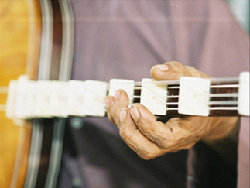
| Capital | : Phnom Penh |
| National Population | : 11 million |
| Language | : Khmer |

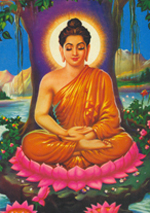
Theravada Buddhism is the official religion in Cambodia which is practiced by 95 percent of the population-- just like that of Thailand, Burma, Sri Lanka. However, Christianity and Cham Muslim are being active and popular among a large number of population as well in the capital and provinces, showing a sign of growth. Daoism and Confuism are also commonly practiced among the Chinese people.
Earning merit is an important part of Buddhist life. Buddhists in Cambodia earn merit by giving money, goods, and labor to the temples, or by providing one of the two daily meals of the monks.
Children often look after the fruits trees and vegetable gardens inside their local wat, or temple. Boys can earn merit by becoming temple servants or novice monks for a short time. Most young men remain monks for less than a year.

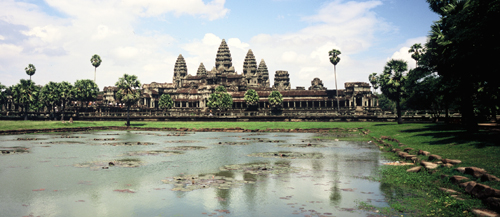
Angkor Wat
To ensure order and harmony in the universe, Angkor's architects and sculptors created stone temples that symbolized the cosmic world and decorated them with wall carvings and sculptures of Hindu gods and the Buddha. Religious guidelines dictated that a basic temple layout include a central shrine, a courtyard, an enclosing wall, and a moat. More than 60 of these temple complexes survive in the Angkor region. In addition, several stone bridges and reservoirs built in the Angkor period are still in use. Many Cambodian public buildings, such as the Royal Palace in Phnom Penh, are decorated in the Khmer architectural style and use motifs such as the garuda, a mythical bird in the Hindu religion.
After the devastation of culture in the Khmer Rouge era, the traditional arts and handicrafts of Cambodia are reviving. Notable among these traditional arts are textiles, silver work, basketry, woodcarving, stone sculpture, and painting. Artisans use cotton to weave the krama, a rectangular scarf made in colorful checks and stripes, and the sampot, a skirt for women. Beautiful silk sampots with elaborate, multicolored patterns, often entwined with gold or silver thread, are woven using the ikat technique, in which each individual thread is tied. Cambodia's long tradition of metal work nearly disappeared, but the French revived it in the early 20th century. Silversmiths produced popular items of the period, such as animal-shaped boxes, intricately decorated, that were used to hold the ingredients of a preparation known as betel, which is chewed as a stimulant and tonic.

|
|
|
Khmer Traditional Apsara Dance |
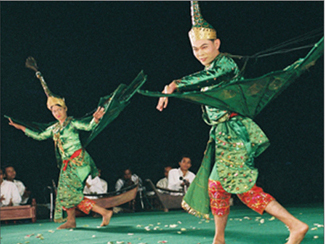 |
| Peacock Dance |
|
Musical instruments (Chapei) |
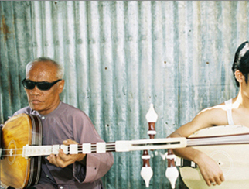 |
| Chapei Conductors |
Classical Pinpeat of Cambodia, The Cambodian pinpeat ensemble is traditionally heard on feast days in the pagodas. It is also a court ensemble used to accompany classical dance for ritual occasions or theatrical events. The pinpeat is primarily made up of percussion instruments: the roneat ek (high bamboo xylophone), roneat thung (low bamboo xylophone), kong vong touch and kong vong thom (small and large sets of tuned gongs), sampho (two-sided drum), skor thom (two large drums), and sralai (quadruple-reed instrument).
Classical Dance of Cambodia The epic poem of Rama (Ramayana) is believed to have been revealed to a Hindu holy man named Valmiki by Brahma, the god of creation. This religious literary work, dating from about ad 4, is known in various versions throughout India and Southeast Asia. In Cambodia, the story has been set to music and dance and performed by the Royal Ballet since the 18th century. Although the epic is also known in the villages, where it is translated orally or dramatized in the popular shadow puppet theater, the ballet was traditionally a courtly art performed in the palace or for princely festivals. The music of the ballet is performed by the Pinpeat orchestra, which is made up of traditional xylophones, metallophones, horizontal gongs, drums, and cymbals.
Khmer classical dance derived from Indian court dance, which traces its origins to the apsarases of Hindu mythology, heavenly female nymphs who were born to dance for the gods. The traditions of Thailand and Java (in Indonesia) also influenced the music and dance of Cambodia. In classical Cambodian dance, women, dressed in brightly colored costumes with elaborate headdresses, perform slow, graceful movements accompanied by a percussive ensemble known as the pinpeat. Pinpeat orchestras include drums, gongs, and bamboo xylophones. In Cambodia's villages, plays performed by actors wearing masks are popular. Shadow plays, performed using black leather puppets that enact scenes from the Reamkern, are also enjoyed. Folk dancing is popular in rural Cambodia and is performed spontaneously to a drumbeat.

| 01 January | International New Year's Day |
| 07 January | 7 January Day |
| 08 March | International Women's Day |
| 03 April | Cultural Day |
| 14-15-16 April | Cambodian New Year |
| 01 May | International Labor Day |
| 15 May | Visak Bochea Day |
| 19 May | Royal Ploughing Ceremony |
| 01 June | International Children's Day |
| 18 June | Queen's Birthday, samdech Preah Mohèsey Norodom Monineath Sihanouk |
| 24 September | Constitution Day, 5th Anniversary of Re Coronation of H.M. Preah Bat Samdech Preah Norodom Sihanouk |
| 24-25-26 September | Pchum Ben Day |
| 23 October | Paris Peace Accord on Cambodia |
| 30-31 October and 01 November | King's Birthday, H.M. Preah Bat Samdech Preah Norodom Sihanouk |
| 07-08-09 November | Water Festival, Moon Festival |
| 09 November | Independence Day |
| 10 December | UN Human Rights Day |

Several festivals are held annually which are of interest to both international and domestic tourists. The major festivals are as follows:
Bonn Chaul Chhnam(April) is the traditional New Year's festival when Khmers clean and decorate their houses, make offerings and play traditional games.
Bonn Chroat Preah Nongkoal (May) is the Royal Ploughing Ceremony which inaugurates the planting season and involves symbolic ploughing and sowing of seed.
Bonn Dak Ben and Bonn Pchoum Ben (September) is the festival held for commemoration of the spirits of the dead; 15 days later offerings are made in the temples.
Bonn Kathen (October) is a 29-day religious festival when people march in procession to the temples where the monks change from their old to new robes.
His Majesty the King's Birthday (30 October - 1 November) is celebrated in regal fashion and the Royal Palace is sometimes open to the public.
Independence Day (9 November) celebrates the date when Cambodia achieved independence from France in 1953.
Bonn Om Took (November) is the water festival which ushers in the fishing season and marks the reversing of the current in the Tonle Sap River. This very popular festival attracts many people to watch the longboat races on the Tonle Sap in Phnom Penh, fireworks and a lighted flotilla of boats.
(Source:Cambodia e-Gov/Tourism of Cambodia)












